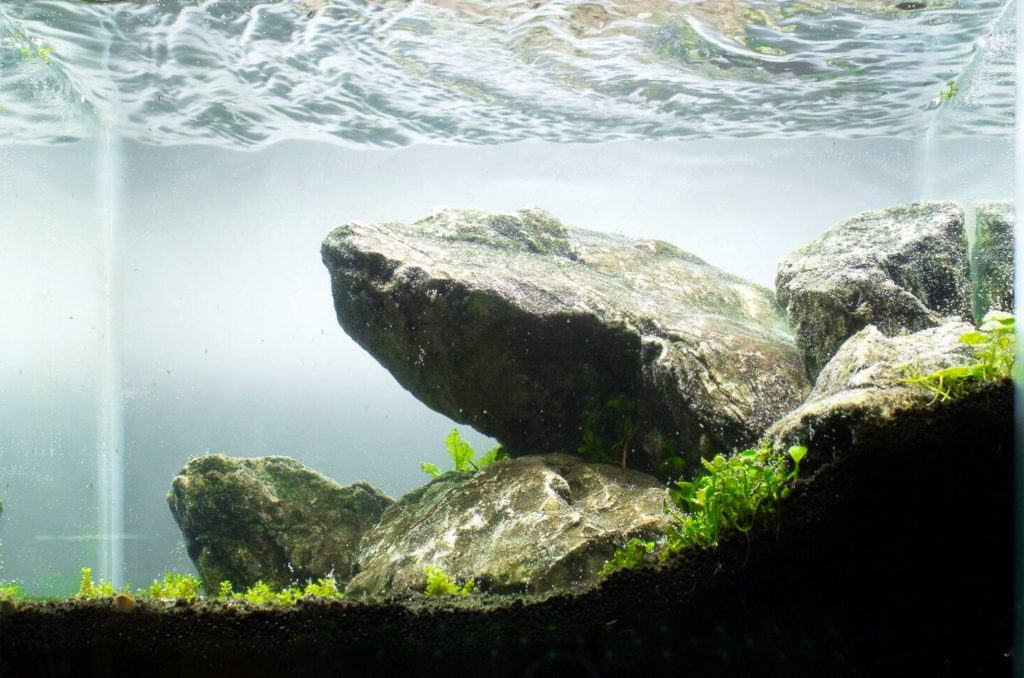For aquarists who want to take their game one step further, aquascaping can be an enticing concept. Aquascaping generally refers to the craft of designing the concept of your aquarium, from choosing the types of plants you want to have to the substrate you will use.
Aquascaping can be quick and simple, or it can cumbersome and complex. Of all the aquscaping types, perhaps the hardest one to pull off is the Iwagumi style.

The Iwagumi aquarium is a deceptively simple-looking tank that requires a lot of meticulous and complicated work to achieve.
Beginners are generally advised to begin with simpler aquascaping styles, as an Iwagumi requires both discipline and experience. However, as hard it is to pull off, an Iwagumi tank is simplistically beautiful, and worth it in the long run.
Iwagumi literally translates to ‘rock formation.’ It was a term coined about thirty years ago by Japanese aquarist Takashi Amano.
It quickly grew into popularity due to its breathtaking effect. The Iwagumi aquascape style values simplicity, peace, and beauty.
Contents
Iwagumi Aquascape
Sanzon Iwagumi
Sanzon is one of many aquascaping types under the classic Iwagumi style. The Sanzon is a Japanese fish tank aquascape and is considered to be the most traditional element of all Iwagumi – classic and modern.
The word ‘sanzon’ translates to ‘three pillar,’ which refers to the three rocks that make up its design. The three pillars of a Sanzon Iwagumi is comprised of one large rock and two smaller rocks.
The large rock often called the master, is situated in the center of the aquarium. The two smaller rocks, called attendant stones, are placed to the right and left of the master.
This arrangement adheres to the triadic component of Buddhism, and dates as far back as the eleventh century.
The Sanzon Iwagumi can be found as part of a larger arrangement, such as that of the modern Iwagumi-centric aquariums that most of us are familiar with.
Modern Iwagumi
The modern Iwagumi style as we know of it today takes its roots from the Sanzon Iwagumi.
Just like the Sanzon, an Iwagumi tank focuses on creating feelings of peace, beauty and tranquillity, and achieves this by focusing on the stonework in your aquarium.

To begin, you will need to choose an odd number of stones. Iwagumi tanks that are made with an even number of stones are hard to pull off. This is because the concepts of peace and tranquillity rely on the presence of asymmetrical elements.
In nature, instances of symmetry are rare. We unconsciously connect symmetry with synthetic, man-made forces, which creates a feeling of disharmony. Even stones present symmetry, which detracts from the feeling of balance in an Iwagumi tank.
Iwagumis need three types of rocks: the largest rock, medium rocks, and smaller rocks. The medium rocks should be 2/3 in size to the largest stone, and the smallest are 1/3 in size to the largest.
The largest stone should be placed off center. Medium rocks are positioned to accent the main rock. The smallest rocks, sometimes called sacrificial stones, will eventually be covered by your plant life; consider this eventuality when planning your aquascape.
Plants to Use
The Iwagumi style is pulled off by causing viewers’ attention to your rock formation. Thus, the plants that you can use in an Iwagumi are limited to no more than foreground plants. Common choices include the Dwarf Hairgrass, Dwarf Baby Tears, and the Micro Sword.
This is where the difficulty of Iwagumi mainly lies. Due to the lack of stem plants, problems in nutrient cycling may arise. Paired with high light levels, algal blooms can quickly become your greatest problem.
This issue is commonly solved by introducing shrimp to eat the algae. A common choice is the Amano Shrimp, Caridina multidentate.
It may also help to interrupt light for about an hour in the middle of the day during the first several weeks of owning your tank.

Aquarists will have to observe patience as the plants grow at their sluggish pace, and you’ll have to regularly trim back plant growth for maintenance.
Fish to Use
In choosing the fish to include in your Iwagumi tank, it is best to avoid shoaling fish, as fish that break away from the group create disharmony in your tank.
Instead, opt for small, slender, schooling fish; common choices include the Rasboras (like the Harlequin and Galaxy Rasbora) and tetras (like the Neon and Cardinal Tetras).
A Word of Caution
Iwagumis are deceptively simple, and their difficulty lies in this simplicity. They are known to be one of the hardest tanks to maintain, and beginners are generally discouraged from pursuing an Iwagumi type tank.
However, it is always necessary to be meticulous and patient. Be sure to keep track of tank conditions, especially in terms of water filtration and substrate choices.
Regular, meticulous maintenance and a close observation of tank conditions are important to keep algal blooms at bay.
Many aquarists find themselves with the need to start over a few times before finding the correct balance for their tank.
Here’s a video showing more information on how to achieve an Iwagumi tank.
Do you have any tips on making an Iwagumi tank?

